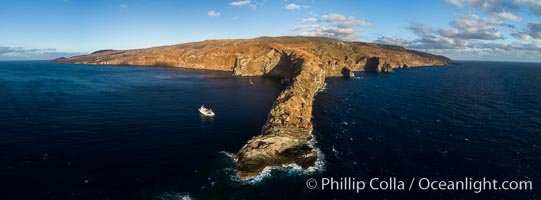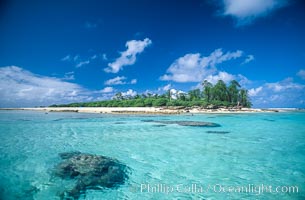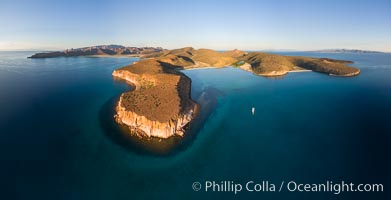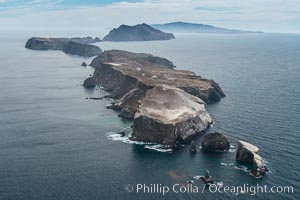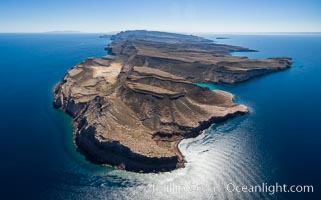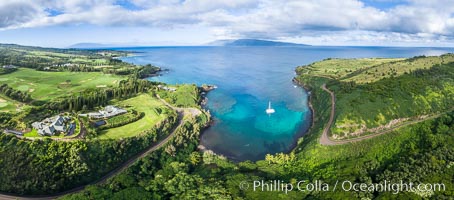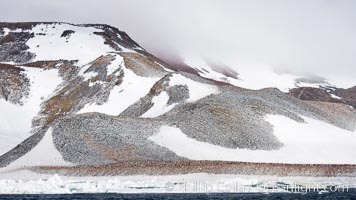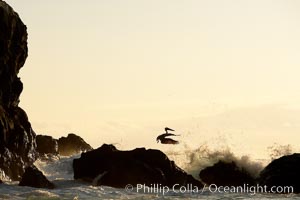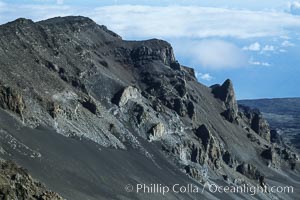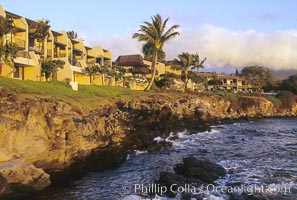
San Clemente Island Pyramid Head, the distinctive pyramid shaped southern end of the island. San Clemente Island Pyramid Head, showing geologic terracing, underwater reefs and giant kelp forests.

Parasitic zoanthid anemones cover, encrust and overwhelm a golden gorgonian. The gorgonian on the left has been completely parasitized by zoanthid anemones, while the gorgonian to the right remains free of zoanthids (for now). A garibaldi swims below the two sea fans. The golden gorgonian is a filter-feeding temperate colonial species that lives on the rocky bottom at depths between 50 to 200 feet deep. Each individual polyp is a distinct animal, together they secrete calcium that forms the structure of the colony. Gorgonians are oriented at right angles to prevailing water currents to capture plankton drifting by.

The Kelp Forest and Rocky Reef of San Clemente Island. Giant kelp grows rapidly, up to 2' per day, from the rocky reef on the ocean bottom to which it is anchored, toward the ocean surface where it spreads to form a thick canopy. Myriad species of fishes, mammals and invertebrates form a rich community in the kelp forest. Lush forests of kelp are found throughout California's Southern Channel Islands.

Red gorgonian on rocky reef, below kelp forest, underwater. The red gorgonian is a filter-feeding temperate colonial species that lives on the rocky bottom at depths between 50 to 200 feet deep. Gorgonians are typically oriented at right angles to prevailing water currents to capture plankton drifting by.

San Clemente Island aerial photo, Pyramid Head and Balanced Rock (China Hat) at the southern end of the island. San Clemente Island Pyramid Head, the distinctive pyramid shaped southern end of the island, exhibits distinctive geologic terracing, underwater reefs and giant kelp forests.

Sunrise at San Clemente Island, south end showing China Hat (Balanced Rock) and Pyramid Head, near Pyramid Cove, storm clouds. Panoramic photo.

Guadalupe Island at sunrise, panorama. Volcanic coastline south of Pilot Rock and Spanish Cove, near El Faro lighthouse.

Punta Norte, the northern point of Guadalupe Island, viewed from the north. Punta Desfiladero (Blunt Point) and Roca Elefante are just visible at far right, and Roca Piloto (Pilot Rock) is see to the left of the island against the distant sweep of the cliffs that comprise the northeastern bight of the island, actually the rim of an enormous caldera.
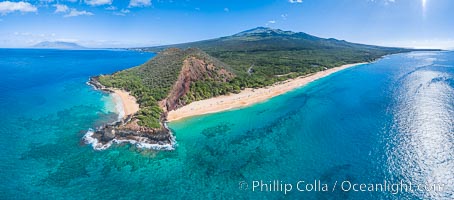
Makena Beach State Park aerial photo, Maui, Hawaii. Big Beach on the right, Little Beach on the left, Haleakala rising in the distance on the right, West Maui Mountains in the distance on the left.
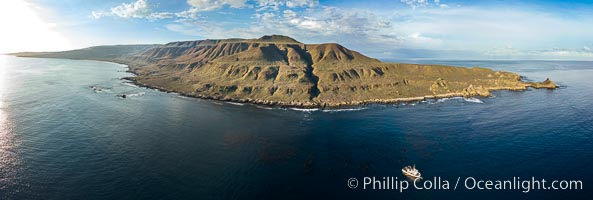
San Clemente Island aerial photo, Pyramid Head and Balanced Rock at the southern end of the island. San Clemente Island Pyramid Head, the distinctive pyramid shaped southern end of the island, exhibits distinctive geologic terracing, underwater reefs and giant kelp forests.

North Coronado Island, Mexico, northern point looking south with Middle and South Islands in the distance, aerial photograph.

Aerial panorama of Clipperton Island, showing the entire atoll. Clipperton Island, a minor territory of France also known as Ile de la Passion, is a small (2.3 sq mi) but spectacular coral atoll in the eastern Pacific. By permit HC / 1485 / CAB (France).

The French tricolor flag flies over Clipperton Island at sunset. Clipperton Island, a minor territory of France also known as Ile de la Passion, is a spectacular coral atoll in the eastern Pacific. By permit HC / 1485 / CAB (France).

Darwin's Arch, a dramatic 50-foot tall natural lava arch, rises above the ocean a short distance offshore of Darwin Island. On June 10, 2021, Darwin's Arch broke and fell into the ocean, leaving behind two partial pillars.

Coconut palm trees on Clipperton Island, aerial photo. Clipperton Island is a spectacular coral atoll in the eastern Pacific. By permit HC / 1485 / CAB (France).

Coral Reef at Clipperton Island, aerial photo. Clipperton has healthy, beautiful coral reefs. The white beaches are composed of white coralline rubble. Clipperton Island, a minor territory of France also known as Ile de la Passion, is a spectacular coral atoll in the eastern Pacific. By permit HC / 1485 / CAB (France).

Aerial panorama of Clipperton Island, showing the entire atoll. Clipperton Island, a minor territory of France also known as Ile de la Passion, is a small (2.3 sq mi) but spectacular coral atoll in the eastern Pacific. By permit HC / 1485 / CAB (France).
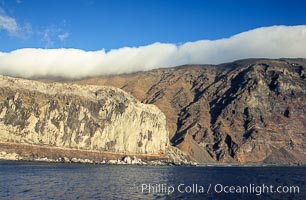
Clouds held back by island crest, near the north end of Guadalupe Island off the coast of Baja California, Mexico.

San Clemente Island aerial photo, Pyramid Head and Balanced Rock at the southern end of the island. San Clemente Island Pyramid Head, the distinctive pyramid shaped southern end of the island, exhibits distinctive geologic terracing, underwater reefs and giant kelp forests.

San Clemente Island aerial photo, Pyramid Head and Balanced Rock at the southern end of the island. San Clemente Island Pyramid Head, the distinctive pyramid shaped southern end of the island, exhibits distinctive geologic terracing, underwater reefs and giant kelp forests.

Coral Reef at Clipperton Island, aerial photo. Clipperton has healthy, beatiful coral reefs. The white beaches are composed of white coralline rubble. Clipperton Island, a minor territory of France also known as Ile de la Passion, is a spectacular coral atoll in the eastern Pacific. By permit HC / 1485 / CAB (France).

San Clemente Island, aerial photo, steep cliffs and mountainous terrain on the south eastern shore of the island.
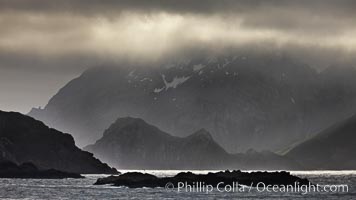
South Georgia Island coastline, showing the island's characteristic rugged topography. 56% of the island is covered by 161 glaciers, which have created numerous large bays and inlets that provide excellent habitat for marine animals and seabirds. Mountains meet the sea in steep-sided seacliffs covered with sparse vegetation. The highest point on South Georgia Island is Mt. Paget at 2,915m.
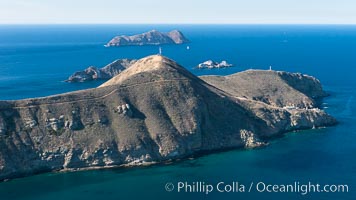
South Coronado Island, Mexico, eastern side, Middle and North Islands in the distance, aerial photograph.

Black-browed albatross in flight, over the enormous colony at Steeple Jason Island in the Falklands.

Steeple Jason Island, southwestern exposure, looking south pass the isthmus toward the southern half of the island. Steeple Jason is one of the remote Jason Group of Islands in the West Falklands. Uninhabited, the island is spectacular both for its rugged scenery and its enormous breeding colony of black-browed albatross. Steeple Jason Island is now owned and administered by the Wildlife Conservation Society.

King penguin colony and the Bay of Isles on the northern coast of South Georgia Island. Over 100,000 nesting pairs of king penguins reside here. Dark patches in the colony are groups of juveniles with fluffy brown plumage. The icebreaker M/V Polar Star lies at anchor.

San Clemente Island aerial photo, Pyramid Head and Balanced Rock at the southern end of the island. San Clemente Island Pyramid Head, the distinctive pyramid shaped southern end of the island, exhibits distinctive geologic terracing, underwater reefs and giant kelp forests.

Gentoo penguins coming ashore, after foraging at sea, walking through ocean water as it wades onto a sand beach. Adult gentoo penguins grow to be 30" and 19lb in size. They feed on fish and crustaceans. Gentoo penguins reside in colonies well inland from the ocean, often formed of a circular collection of stones gathered by the penguins.

Northeastern coast of Steeple Jason Island, looking toward the southern half of the island. Steeple Jason is one of the remote Jason Group of Islands in the West Falklands. Uninhabited, the island is spectacular both for its rugged scenery and its enormous breeding colony of black-browed albatross. Steeple Jason Island is now owned and administered by the Wildlife Conservation Society.

Macaroni penguins, on the rocky shoreline of Hercules Bay, South Georgia Island. One of the crested penguin species, the macaroni penguin bears a distinctive yellow crest on its head. They grow to be about 12 lb and 28" high. Macaroni penguins eat primarily krill and other crustaceans, small fishes and cephalopods.
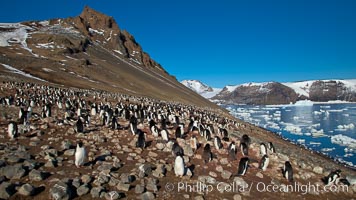
Adelie penguins at the nest, part of the large nesting colony of penguins that resides along the lower slopes of Devil Island.

South Georgia Island coastline, showing the island's characteristic rugged topography. 56% of the island is covered by 161 glaciers, which have created numerous large bays and inlets that provide excellent habitat for marine animals and seabirds. Mountains meet the sea in steep-sided seacliffs covered with sparse vegetation. The highest point on South Georgia Island is Mt. Paget at 2,915m.

King penguin colony at Salisbury Plain, Bay of Isles, South Georgia Island. Over 100,000 pairs of king penguins nest here, laying eggs in December and February, then alternating roles between foraging for food and caring for the egg or chick.
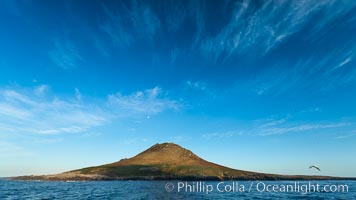
Steeple Jason Island at sunrise, one of the remote Jason Group of Islands in the West Falklands. Uninhabited, the island is spectacular both for its rugged scenery and its enormous breeding colony of black-browed albatross. Steeple Jason Island is now owned and administered by the Wildlife Conservation Society.

Reindeer on South Georgia Island. Reindeer (known as caribou when wild) were introduced to South Georgia Island by Norway in the early 20th Century. There are now two distinct herds which are permanently separated by glaciers.

Adelie penguins navigate a steep dropoff, to get from their nests down to a rocky beach, in order to go to sea to forage for food.
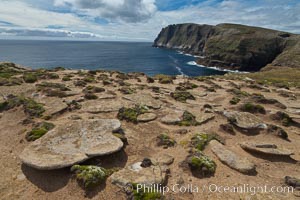
Interesting rock formations on plateau atop New Island, with sheer rugged seacliffs and the ocean beyond.

Beautiful white sand beach, on the southern tip of Carcass Island, with gentoo and Magellanic penguins coming and going to sea.
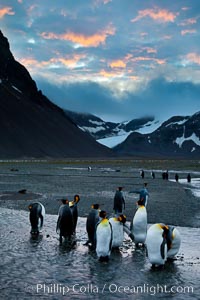
King penguin colony, Right Whale Bay, South Georgia Island. Over 100,000 pairs of king penguins nest on South Georgia Island each summer.

Glacial melt waters, runoff, flows across an alluvial flood plain between mountains, on its way to Stromness Bay.

A forest of giant kelp, growing just below the ocean surface along the shores of San Clemente Island.

Northwest promontory of Santa Barbara Island, part of the Channel Islands National Marine Sanctuary. Santa Barbara Island lies 38 miles offshore of the coast of California, near Los Angeles and San Pedro.
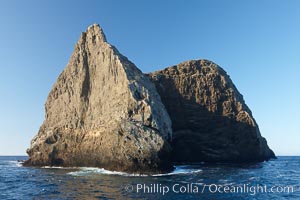
Sutil Island,a small barren island near Santa Barbara Island, part of the Channel Islands National Marine Sanctuary. Santa Barbara Island lies 38 miles offshore of the coast of California, near Los Angeles and San Pedro.

Western landing and National Park buildings on Santa Barbara Island, part of the Channel Islands National Marine Sanctuary. Santa Barbara Island lies 38 miles offshore of the coast of California, near Los Angeles and San Pedro.

Chinstrap penguins at Bailey Head, Deception Island. Chinstrap penguins enter and exit the surf on the black sand beach at Bailey Head on Deception Island. Bailey Head is home to one of the largest colonies of chinstrap penguins in the world.

Distant icebergs, mountains, clouds, ocean at dawn, in the South Shetland Islands, near Deception Island.
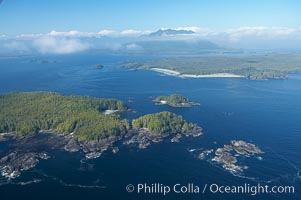
Blunden Island (foreground) and Vargas Island (distance), surrounded by the waters of Clayoquot Sound, west coast of Vancouver Island.

Adelie penguins, nesting, part of the enormous colony on Paulet Island, with the tall ramparts of the island and clouds seen in the background. Adelie penguins nest on open ground and assemble nests made of hundreds of small stones.

Darwin Island, with Darwins Arch on the right. Darwin Island is the northernmost of the Galapagos Islands and is home to enormous numbers of seabirds.

Wolf Island is the largest of the islands in the distant northern island group of the Galapagos archipelago, is home to hundreds of thousands of seabirds. Vast schools of sharks and fish inhabit the waters surrounding Wolf Island.

Kelp fronds grow upward from the reef below to reach the ocean surface and spread out to form a living canopy.

Mangrove shoreline. Mangroves have vertical branches, pheumatophores, that serve to filter out salt and provide fresh water to the leaves of the plant. Many juvenile fishes and young marine animals reside in the root systems of the mangroves. Punta Albemarle.

West Maui and smoke from burning cut sugar cane. Cane fields are often burned to clear cane cuttings, which produces huge amounts of smoke and ash.
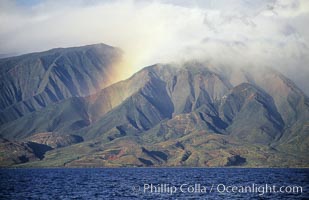
West Maui mountains rise above the coast of Maui, with clouds flanking the ancient eroded remnants of a volcano.

